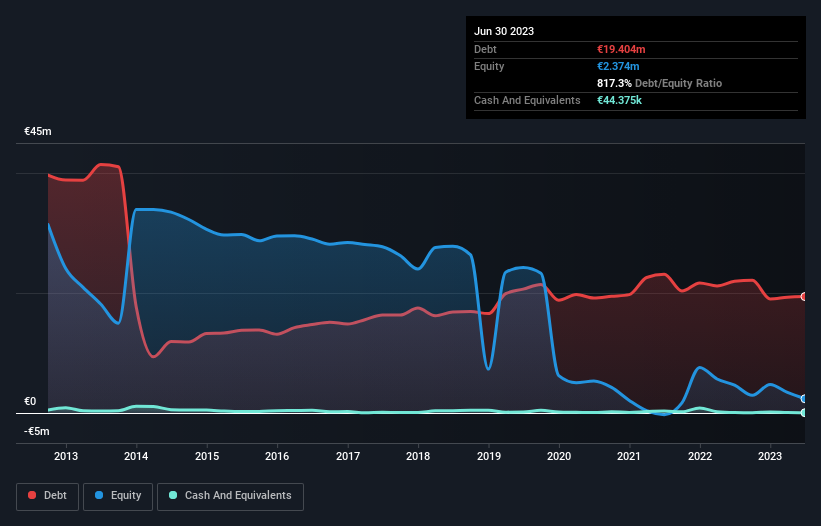Health Check: How Prudently Does Varteks d.d (ZGSE:VART) Use Debt?

Warren Buffett famously said, 'Volatility is far from synonymous with risk.' It's only natural to consider a company's balance sheet when you examine how risky it is, since debt is often involved when a business collapses. As with many other companies Varteks d.d. (ZGSE:VART) makes use of debt. But should shareholders be worried about its use of debt?
Why Does Debt Bring Risk?
Debt and other liabilities become risky for a business when it cannot easily fulfill those obligations, either with free cash flow or by raising capital at an attractive price. If things get really bad, the lenders can take control of the business. However, a more common (but still painful) scenario is that it has to raise new equity capital at a low price, thus permanently diluting shareholders. Of course, plenty of companies use debt to fund growth, without any negative consequences. When we examine debt levels, we first consider both cash and debt levels, together.
See our latest analysis for Varteks d.d
What Is Varteks d.d's Net Debt?
The image below, which you can click on for greater detail, shows that Varteks d.d had debt of €19.4m at the end of June 2023, a reduction from €22.0m over a year. And it doesn't have much cash, so its net debt is about the same.

How Strong Is Varteks d.d's Balance Sheet?
Zooming in on the latest balance sheet data, we can see that Varteks d.d had liabilities of €19.8m due within 12 months and liabilities of €10.4m due beyond that. Offsetting these obligations, it had cash of €44.4k as well as receivables valued at €3.82m due within 12 months. So its liabilities total €26.3m more than the combination of its cash and short-term receivables.
The deficiency here weighs heavily on the €2.46m company itself, as if a child were struggling under the weight of an enormous back-pack full of books, his sports gear, and a trumpet. So we definitely think shareholders need to watch this one closely. At the end of the day, Varteks d.d would probably need a major re-capitalization if its creditors were to demand repayment. When analysing debt levels, the balance sheet is the obvious place to start. But it is Varteks d.d's earnings that will influence how the balance sheet holds up in the future. So if you're keen to discover more about its earnings, it might be worth checking out this graph of its long term earnings trend.
In the last year Varteks d.d had a loss before interest and tax, and actually shrunk its revenue by 3.5%, to €14m. We would much prefer see growth.
Caveat Emptor
Importantly, Varteks d.d had an earnings before interest and tax (EBIT) loss over the last year. Its EBIT loss was a whopping €3.3m. Reflecting on this and the significant total liabilities, it's hard to know what to say about the stock because of our intense dis-affinity for it. Sure, the company might have a nice story about how they are going on to a brighter future. But the reality is that it is low on liquid assets relative to liabilities, and it lost €2.2m in the last year. So we're not very excited about owning this stock. Its too risky for us. There's no doubt that we learn most about debt from the balance sheet. However, not all investment risk resides within the balance sheet - far from it. Case in point: We've spotted 3 warning signs for Varteks d.d you should be aware of.
If, after all that, you're more interested in a fast growing company with a rock-solid balance sheet, then check out our list of net cash growth stocks without delay.
New: Manage All Your Stock Portfolios in One Place
We've created the ultimate portfolio companion for stock investors, and it's free.
• Connect an unlimited number of Portfolios and see your total in one currency
• Be alerted to new Warning Signs or Risks via email or mobile
• Track the Fair Value of your stocks
Have feedback on this article? Concerned about the content? Get in touch with us directly. Alternatively, email editorial-team (at) simplywallst.com.
This article by Simply Wall St is general in nature. We provide commentary based on historical data and analyst forecasts only using an unbiased methodology and our articles are not intended to be financial advice. It does not constitute a recommendation to buy or sell any stock, and does not take account of your objectives, or your financial situation. We aim to bring you long-term focused analysis driven by fundamental data. Note that our analysis may not factor in the latest price-sensitive company announcements or qualitative material. Simply Wall St has no position in any stocks mentioned.
About ZGSE:VART
Varteks d.d
Manufactures and sells clothes for men and women in Croatia and internationally.
Slightly overvalued with weak fundamentals.


